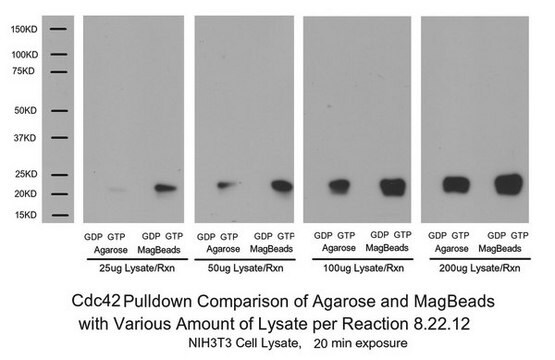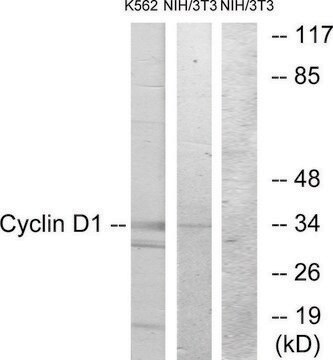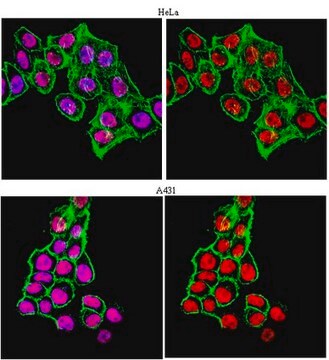ABN1653
Anti-Dysbindin
from rabbit, purified by affinity chromatography
Sinonimo/i:
Biogenesis of lysosome-related organelles complex 1 subunit 8, BLOC-1 subunit 8, Dysbindin-1, Dystrobrevin-binding protein 1, Hermansky-Pudlak syndrome 7 protein, HPS7 protein
About This Item
IF
IHC
IP
WB
immunofluorescence: suitable
immunohistochemistry: suitable (paraffin)
immunoprecipitation (IP): suitable
western blot: suitable
Prodotti consigliati
Origine biologica
rabbit
Livello qualitativo
Forma dell’anticorpo
affinity isolated antibody
Tipo di anticorpo
primary antibodies
Clone
polyclonal
Purificato mediante
affinity chromatography
Reattività contro le specie
human, mouse, rat
tecniche
immunocytochemistry: suitable
immunofluorescence: suitable
immunohistochemistry: suitable (paraffin)
immunoprecipitation (IP): suitable
western blot: suitable
N° accesso NCBI
N° accesso UniProt
Condizioni di spedizione
ambient
modifica post-traduzionali bersaglio
unmodified
Informazioni sul gene
human ... DTNBP1(84062)
Descrizione generale
Specificità
Immunogeno
Applicazioni
Immunohistochemistry Analysis: A representative lot detected Dysbindin in Immunohistochemistry applications (Ito, H., et. al. (2010). Mol Psychiatry. 15(10):976-86).
Immunofluorescence Analysis: A 1,000 dilution from a representative lot detected Dysbindin in P8 mouse brain hippocampus tissue (Courtesy of Dr Koh-ichi Nagata at Aichi Human Service Center).
Immunoprecipitation Analysis: A representative lot detected Dysbindin in Immunoprecipitation applications (Ito, H., et. al. (2010). Mol Psychiatry. 15(10):976-86).
Immunocytochemistry Analysis: A representative lot detected Dysbindin in Immunocytochemistry applications (Yuan, Q., et. al. (2016). Biol Psychiatry. 80(4):312-22).
Western Blotting Analysis: A representative lot detected Dysbindin in Western Blotting applications (Lee, S.A., et. al. (2015). J Biol Chem. 290(11):7087-96).
Immunoprecipitation Analysis: A representative lot detected Dysbindin in Immunoprecipitation applications (Lee, S.A., et. al. (2015). J Biol Chem. 290(11):7087-96).
Western Blotting Analysis: A representative lot detected Dysbindin in Western Blotting applications (Ito, H., et. al. (2010). Mol Psychiatry. 15(10):976-86).
Immunocytochemistry Analysis: A representative lot detected Dysbindin in Immunocytochemistry applications (Ito, H., et. al. (2010). Mol Psychiatry. 15(10):976-86).
Neuroscience
Qualità
Immunohistochemistry Analysis: A 1:250 dilution of this antibody detected Dysbindin in human cerebellum tissue.
Descrizione del bersaglio
Linkage
Stato fisico
Stoccaggio e stabilità
Altre note
Esclusione di responsabilità
Non trovi il prodotto giusto?
Prova il nostro Motore di ricerca dei prodotti.
Codice della classe di stoccaggio
12 - Non Combustible Liquids
Classe di pericolosità dell'acqua (WGK)
WGK 2
Punto d’infiammabilità (°F)
Not applicable
Punto d’infiammabilità (°C)
Not applicable
Certificati d'analisi (COA)
Cerca il Certificati d'analisi (COA) digitando il numero di lotto/batch corrispondente. I numeri di lotto o di batch sono stampati sull'etichetta dei prodotti dopo la parola ‘Lotto’ o ‘Batch’.
Possiedi già questo prodotto?
I documenti relativi ai prodotti acquistati recentemente sono disponibili nell’Archivio dei documenti.
Il team dei nostri ricercatori vanta grande esperienza in tutte le aree della ricerca quali Life Science, scienza dei materiali, sintesi chimica, cromatografia, discipline analitiche, ecc..
Contatta l'Assistenza Tecnica.







